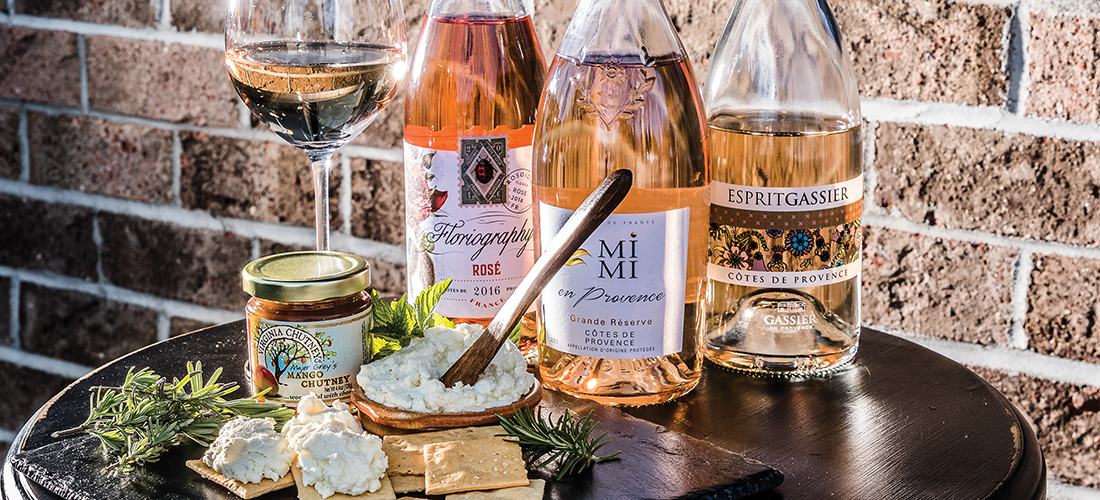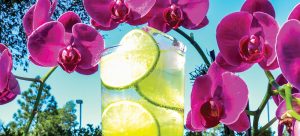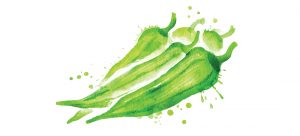
The perfect pairing for spring
By Angela Sanchez
Spring is upon us. The colors are changing and the earth is waking up. The air is warmer and the days are longer. We want to enjoy nature and embrace the change of season. No matter if you are an old friend of rosé or meeting one of my favorite wines for the first time, it’s the perfect choice to embrace this time of year, representing something new, approachable, fresh, clean and light.
Rosé (France), rosato (Italy), rosado (Spain) — depending on what part of the world you are in — has been produced for centuries. It can be from a single varietal, like grenache or pinot noir, or a blend of two or more like cabernet and tempranillo. It ranges in color from a nearly clear pale pink to something darker, almost a fluorescent orange. In style, it can range from bone-dry, crisp and clean with a hint of minerality, to medium sweet or even sweet. The color will be lighter or darker depending on the amount of time — from just a few hours to no longer than a day — that the skins come into contact with the fresh pressed juice, a process known as maceration. Sometimes a less common method called saignée is used when lighter colored juice is removed from a red wine in the early stages of production and made into rosé. There is also a blending method where red and white wines are combined to make rosé, but it’s common only in the making of rosé Champagne or sparkling wine. A key component of rosé production is the lack of aging. It is made to be consumed young and fresh, perfect for spring when the new vintages start to arrive.
The history of rosé is long and varied. Until modern-day winemaking techniques were widely practiced, most of the world’s red wines were rosé in color rather than the ruby red we know today. One of the world’s most famous rosé producing regions, Provence, in the south of France, has been producing rosé for centuries. In the late 19th and throughout the 20th century Provence’s rosé production increased along with tourism and the culinary renown of the region. Today, the classic Provençal style of rosé is becoming more and more popular throughout the winemaking world. Extremely food-friendly, it’s dry, pale and almost skeletal in structure, with notes of dried apricots and brier fruit — strawberry and tart raspberry — with hints of thyme on the finish. Highly versatile, it’s perfect for a brunch of quiche and pastry; for snacks of cheese, olives and charcuterie; or with a dinner of spring greens salad with pea shoots, sweet peas, chèvre and mountain trout or young lamb roasted over a fire with new potatoes in bright green olive oil. This drier, cleaner, lighter-in-color style is currently the trend for rosé and it can vary widely in the varietal makeup of the wine. A decade ago a winemaker from a famous southern Rhône wine-producing family told me rosé should only be made from grenache grapes, or at least grenache should be the dominate grape in a blend. In the south of France, grenache yields those beautiful brier fruit, black cherry, dried herbs and spice notes and makes a great varietal for blending (especially with heavier varietals like syrah — also grown widely in the south of France), adding generosity and lightness to the wine. In Spain, tempranillo makes a slightly heavier style rosé on its own or when it’s blended with grenache. It’s dry and crisp with notes of orange and lime peel and different fruit markers like mandarin orange, kiwi and watermelon along with the familiar strawberry. In California the colors still vary from lighter to darker and varietals can range from grenache to pinot noir to cabernet sauvignon. Pinot noir-based rosés offer tart cherry and peach while a blend based on grenache will have a bit more acidity and notes of grapefruit and melon. Chile and Argentina are producing rosés from pinot gris to malbec. Varying widely in color and style, they range from light and crisp with a note of capsaicin to rich and dense with darker fruit notes like plum.
Of course rosé is great on its own but how much better and more fun is it to have with cheese? This time of year goat cheese, or chèvre, is at its best when sourced from small farms that let their herds graze on new tender grasses and leaves growing naturally. Spring means baby goats and baby goats mean milk. Mothers are birthing and feeding as well as providing for the farm to make cheese. The combination of a fresh spring diet and an abundance of milk makes for chèvre that has a tart, slightly herbaceous flavor with a light and creamy consistency. Rosé and chèvre are welcoming and made to enjoy while young and fresh. So grab a bottle of rosé, a bit of chèvre and find a blooming dogwood to sit under to enjoy the tastes of spring. PS
Angela Sanchez owns Southern Whey, a cheese-centric specialty food store in Southern Pines, with her husband Chris Abbey. She was in the wine industry for 20 years and was lucky enough to travel the world drinking wine and eating cheese.





